Fracture Toughness: Part One
Abstract
Fracture toughness represents a critical material property that defines the resistance to crack propagation under various loading conditions. This comprehensive analysis examines plastic zone formation near crack tips, where materials develop plastic strains as yield stress thresholds are exceeded. The plastic zone size depends significantly on stress conditions, with plane stress and plane strain states exhibiting distinct behaviors. Monotonic loading produces larger plastic zones compared to cyclic loading conditions, where reversed plastic zones are approximately four times smaller. The critical stress intensity factor (Kc) determines fracture toughness, with plane strain fracture toughness (KIc) serving as a geometry-independent material property. Understanding these relationships proves essential for designing against unstable fracture in engineering applications, particularly when considering temperature and specimen thickness dependencies.
Introduction to Plastic Zone Development in Fracture Mechanics
Materials subjected to crack-tip stress concentrations develop plastic strains when local stresses exceed the material's yield strength. This plastic deformation occurs in a localized region surrounding the crack tip, while the surrounding material maintains its elastic behavior. The extent and characteristics of this plastic zone significantly influence the fracture behavior of the material and depend critically on the stress state conditions within the structural component.
The fundamental understanding of plastic zone formation provides essential insights into fracture toughness behavior and enables engineers to predict material performance under various loading scenarios. The relationship between plastic zone size and stress conditions forms the foundation for linear elastic fracture mechanics (LEFM) applications in engineering design.
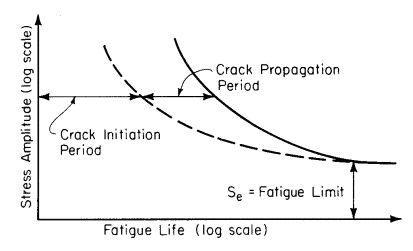
Figure 1: Yielding near crack tip
Stress State Conditions: Plane Stress versus Plane Strain Behavior
Plane Stress Conditions in Thin Sections
In thin-walled structures, the stress component acting through the thickness direction (σz) cannot vary significantly due to geometric constraints imposed by the reduced section thickness. Since no stresses can exist normal to free surfaces, the through-thickness stress σz equals zero throughout the cross-section, resulting in a biaxial stress state. This configuration defines plane stress conditions, which typically occur in thin plates, sheets, and similar structural components where thickness dimensions are relatively small compared to other geometric parameters.
Plane Strain Conditions in Thick Sections
Thick structural sections exhibit material constraint in the thickness direction due to substantial cross-sectional dimensions, resulting in zero strain in the z-direction (εz = 0). This constraint defines plane strain conditions, where Poisson's effect generates significant stress components in the thickness direction (σz). The increased constraint associated with plane strain conditions creates maximum stress triaxiality, consequently producing smaller plastic zones compared to those developed under plane stress conditions.
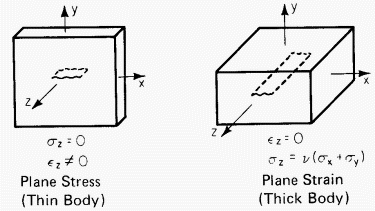
Figure 2: Plane stress and plane strain conditions
Monotonic Plastic Zone Size Analysis
The plastic zone dimensions under monotonic loading conditions can be estimated using established fracture mechanics relationships. For plane stress conditions, the plastic zone size extends further from the crack tip due to reduced constraint effects, while plane strain conditions produce more confined plastic zones due to enhanced triaxial stress states. The plastic zone sizes under monotonic loading have been estimated to be:
 |
plane stress | (1) |
 |
plane strain |
where r is defined as shown in Figure 3.
These relationships demonstrate the fundamental dependence of plastic zone size on both the applied stress intensity factor and the material's yield strength. The geometric parameter r, measured from the crack tip, defines the extent of plastic deformation within the material structure.
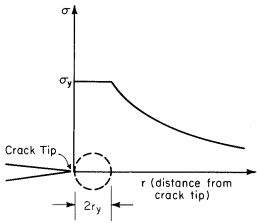
Figure 3: Monotonic plastic zone size
Cyclic Loading Effects on Plastic Zone Formation
Reversed Plastic Zone Characteristics
The reversed or cyclic plastic zone size is four times smaller than the comparable monotonic value. As the nominal tensile load is reduced, the plastic region near the crack tip is put into compression by the surrounding elastic body. The change in stress at the crack tip due to the reversed loading is twice the value of the yield stress.
 |
plane stress | (2) |
 |
plane strain |
The significantly reduced plastic zone size under cyclic loading conditions approaches plane strain behavior characteristics, even in relatively thin plate structures. This behavior enables the application of linear elastic fracture mechanics concepts to fatigue crack growth analysis, even in materials exhibiting considerable ductility. The fundamental assumption that plastic zone dimensions remain small relative to both crack length and overall specimen geometry typically remains valid under these conditions.
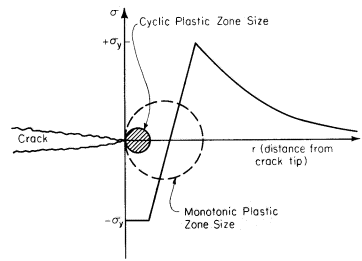
Figure 4: Reversed plastic zone size
Critical Stress Intensity Factor and Fracture Toughness Properties
Defining Fracture Toughness Parameters
Fracture toughness represents the critical value of stress intensity factor (Kc) at which unstable crack propagation occurs. This material property can be conceptualized as the limiting value of stress intensity, analogous to how yield stress represents the limiting value of applied stress in conventional strength analysis. The fracture toughness value provides essential design criteria for preventing catastrophic failure in structural applications.
Specimen Thickness Effects on Fracture Toughness
Fracture toughness values exhibit dependence on specimen thickness until maximum constraint conditions are achieved. These limiting conditions correspond to plane strain states, where constraint effects reach their maximum levels. The plane strain fracture toughness (KIc) represents a fundamental material property independent of specimen geometry, depending primarily on metallurgical factors and testing conditions.
Standardized Testing Procedures
The American Society for Testing and Materials (ASTM) Designation E-399 establishes standardized procedures for determining plane strain fracture toughness values in metallic materials. These testing protocols ensure consistent and reliable fracture toughness measurements across different laboratories and applications. However, obtaining valid KIc measurements can prove challenging, particularly for thin sections of high-toughness materials, where alternative Kc values under specific test conditions may be more appropriate.
Temperature and Thickness Dependencies in Fracture Toughness
Fracture toughness properties demonstrate significant sensitivity to both temperature and specimen thickness variations. These dependencies must be carefully considered during material selection and structural design processes. Lower temperatures typically reduce fracture toughness values, while increased specimen thickness generally promotes plane strain conditions and correspondingly lower toughness values.
Understanding these relationships proves crucial for designing against unstable fracture propagation in engineering structures. The selection of appropriate fracture toughness values for design calculations requires careful consideration of service temperature ranges, structural thickness dimensions, and anticipated loading conditions.
Practical Applications in Engineering Design
The principles of fracture toughness and plastic zone analysis find extensive application in structural integrity assessments, component life prediction, and failure prevention strategies. Engineers utilize these concepts to establish safe operating limits, predict crack growth rates, and design inspection intervals for critical structural components.
The integration of fracture mechanics principles with traditional strength-based design approaches provides comprehensive frameworks for ensuring structural reliability while optimizing material utilization and component weight. These methodologies prove particularly valuable in aerospace, pressure vessel, and infrastructure applications where failure consequences are severe.
Conclusion
Fracture toughness analysis provides fundamental insights into material behavior under crack-tip loading conditions, enabling engineers to predict and prevent catastrophic failure modes. The relationships between plastic zone size, stress state conditions, and critical stress intensity factors form the foundation for modern fracture mechanics applications in engineering design. Understanding these principles ensures safe and reliable structural performance across diverse engineering applications.
Получите доступ к характеристикам механики разрушения тысяч материалов!
Total Materia Horizon содержит уникальные данные по механике разрушения: K1C, KC, параметры роста трещин, параметры по закону Парижа и многое другое для тысяч сплавов и термообработок.
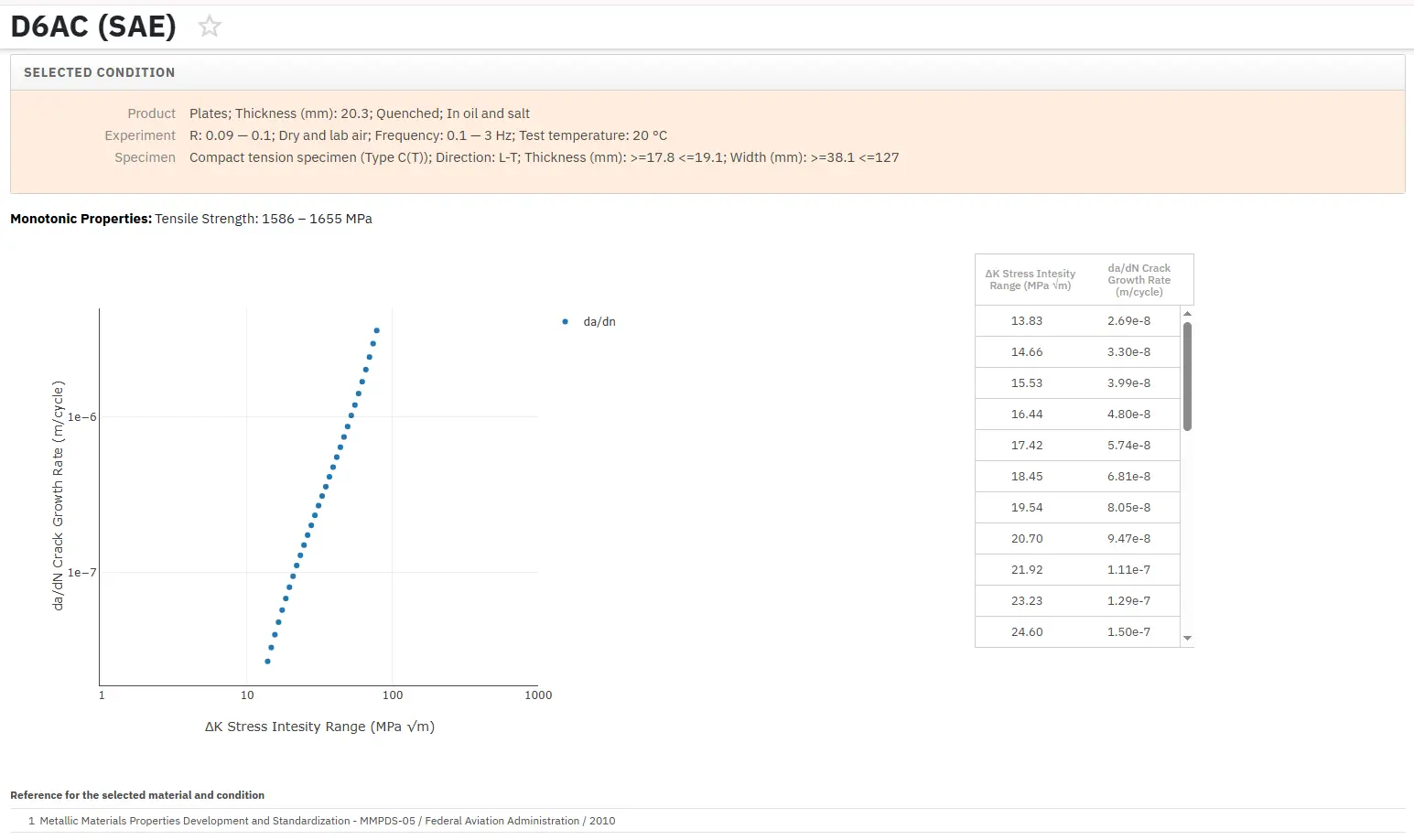
Получите бесплатный тестовый аккаунт в Total Materia Horizon и присоединяйтесь к сообществу из более чем 500 000 пользователей из 120+ стран.